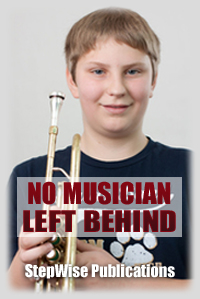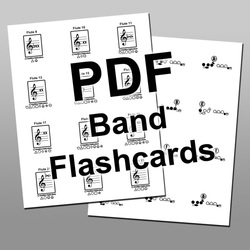 My job as a band/orchestra teacher has been a lot easier since I started using "Music Binders". Such a lovely, bland name, isn't it? I probably should call them "Secret Codebooks of Sonic Awesomeness" or something, but for now each binder has a printed spine (this year's color of card stock is lime green) that simply says "Music Binder ___" (a number between 1-43 goes in each space) slid into the clear plastic cover. Yep, they are pretty dang awesome! Materials & Costs Anyone who wants to use the system I am suggesting here will have to deal with a couple of logistical problems. First, you will need a rack or some other system for keeping the binders organized and accessible to the students as they enter your classroom each period. Second, you will need a small but hefty chunk of money to purchase the binders, sheet protectors, dry erase markers, and zipper pouches. I was personally able to use my killer carpentry skills to convert a couple of shelves into racks that perfectly accommodate up to 80 binders. I also used school textbook funds (with full disclosure to my principal) combined with band funds to purchase 50 white view binders from the district warehouse for $3 each, along with zipper pouches ($1 each), white board markers, and tons of sheet protectors from Wal-Mart for a grand total of less than $300. This is some of the best money I have EVER spent!
5 Comments
 Having taught band for 17 years, I am very aware of the tendency for SOME beginning band and orchestra students to get overwhelmed with note reading after getting to the 4th, 5th, and 6th notes. I have seen this happen every year around the 3rd month of school. As I continue to lead my classes through the method book, teaching new notes and concepts day after day, hoping that everyone is building a comprehensive understanding of music notation, some of my students begin a secret struggle to keep up with the rest of the class. How Some Begin to Slip I don't notice which students are falling behind at first, because kids don't tend to raise their hands and say, "Mr. Winters, I feel stupid right now, and I am getting totally lost!". Instead they revert to various coping mechanisms, such as trying to play by ear or watching the fingerings of students around them. At the same time they stop focusing on building logical schemata for how their fingerings are organized, because they don't feel like there is any comprehensible order to all the lines, spaces, and accidentals they see, and the keys they press, or fingers they place, or positions they move their slides to. They come to believe that our system of music notation and correlating fingerings is a jumbled mess of unconnected factoids that are impossible to memorize. When they refer to the fingering chart in the back of the method book they can find each note's fingering, but not a way to organize the hundreds of bits of information so it can be easily memorized. After teaching for several years I finally noticed this pattern of "losing" a small percentage of young musicians by the 3rd month, and I became obsessive about figuring out how I could teach so that no musician was left behind! |
Author
Curtis Winters has taught band, orchestra, and jazz band at a small Title 1 junior high school in Orem, UT for 18 years. Archives
May 2018
Categories
|


 RSS Feed
RSS Feed

